2024 Trek Emonda vs Cannondale SuperSix Evo
In this article, our bike expert Alex Lee breaks down the differences between the Trek Emonda and Cannondale SuperSix Evo, comparing the models, features, technologies and pricing.
This article compares the Cannondale Supersix EVO and Trek Emonda .
I’ll help you understand the bike model lineups, specifications, and suggested retail prices in USD. I’ll explain the carbon fiber technology ( Cannondale BallisTec and Trek OCLV ) and innovative frameset technologies on each bike.
The objective is to provide you with a clearer understanding of Cannondale Supersix EVO and Trek Emonda .

Cannondale Supersix EVO
Trek emonda, cannondale vs trek carbon fiber, frameset technologies and innovations, where to buy.
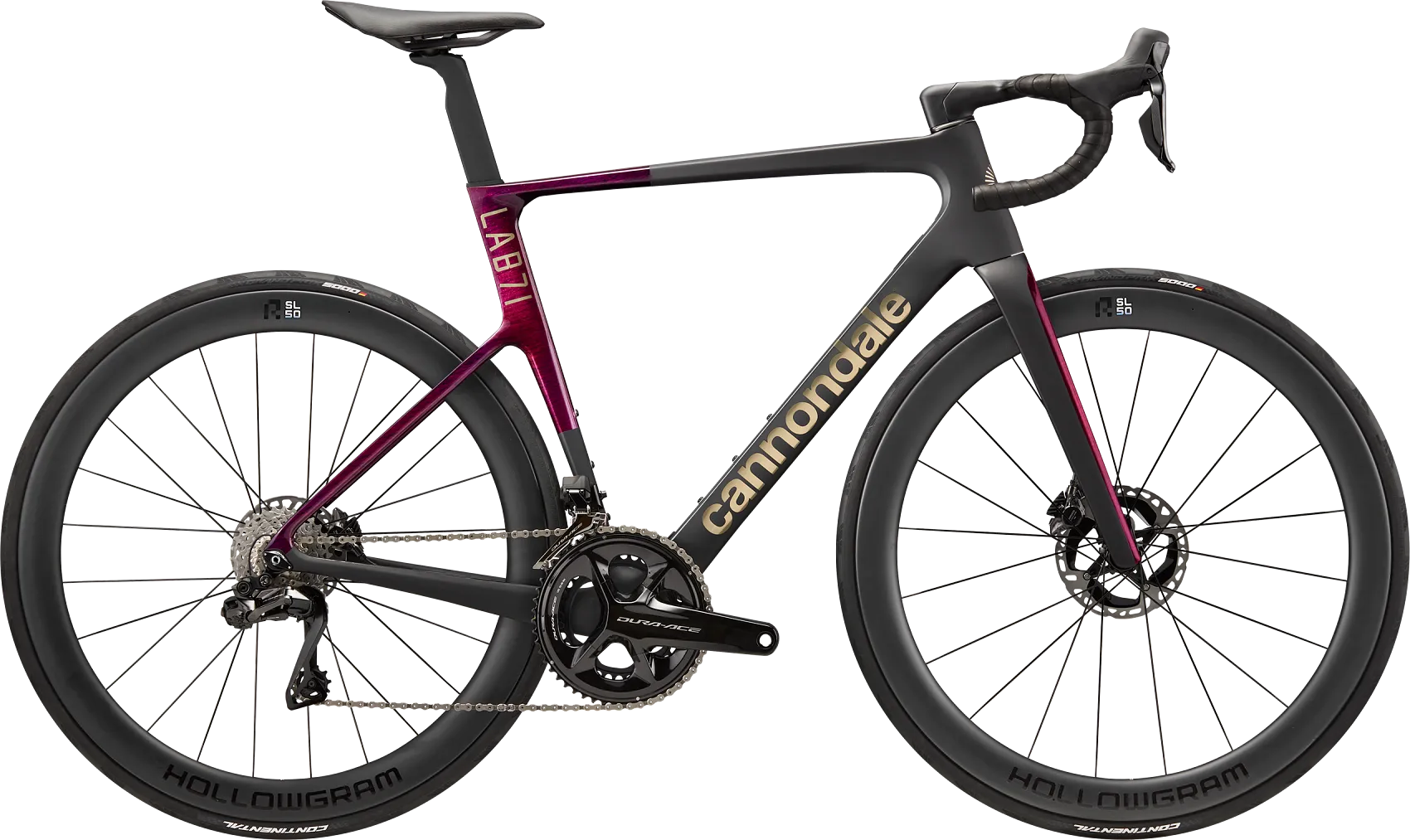
The Cannondale SuperSix EVO is an all-rounder race bike .
For years, the Cannondale SuperSix EVO been known for being light, fast, and stiff on the climbs. At one point, many weight weenies were building sub-6kg bikes with the Cannondale SuperSix EVO.
In 2023, Cannondale launched the ultra-premium LAB71 version featuring their latest Series 0 (LAB71) carbon, taking over from the Hi-MOD version as the top-of-the-line offering. Three carbon grades are now used for the SuperSix EVO; BallisTec LAB71 , BallisTec Hi-MOD , and BallisTec .
All Cannondale SuperSix EVO models are now electronic shifting and disc brake only. The flagship LAB71 models are equipped with Shimano Dura-Ace Di2 only.
Cannondale SuperSix Evo vs others
2024 Cannondale SuperSix Evo vs BMC Teammachine SLR
2024 Cannondale Supersix Evo vs Canyon Ultimate
2024 Cannondale SuperSix Evo vs Cervelo R5
2024 Cannondale Supersix Evo vs Orbea Orca
2024 Cannondale Supersix Evo vs Pinarello Dogma F
2024 Cannondale SuperSix Evo vs Pinarello F
2024 Cannondale Supersix Evo vs Scott Addict RC
2024 Giant TCR Advanced vs Cannondale SuperSix Evo
2024 Specialized Aethos vs Cannondale SuperSix Evo
2024 Specialized Tarmac SL7 vs Cannondale SuperSix Evo
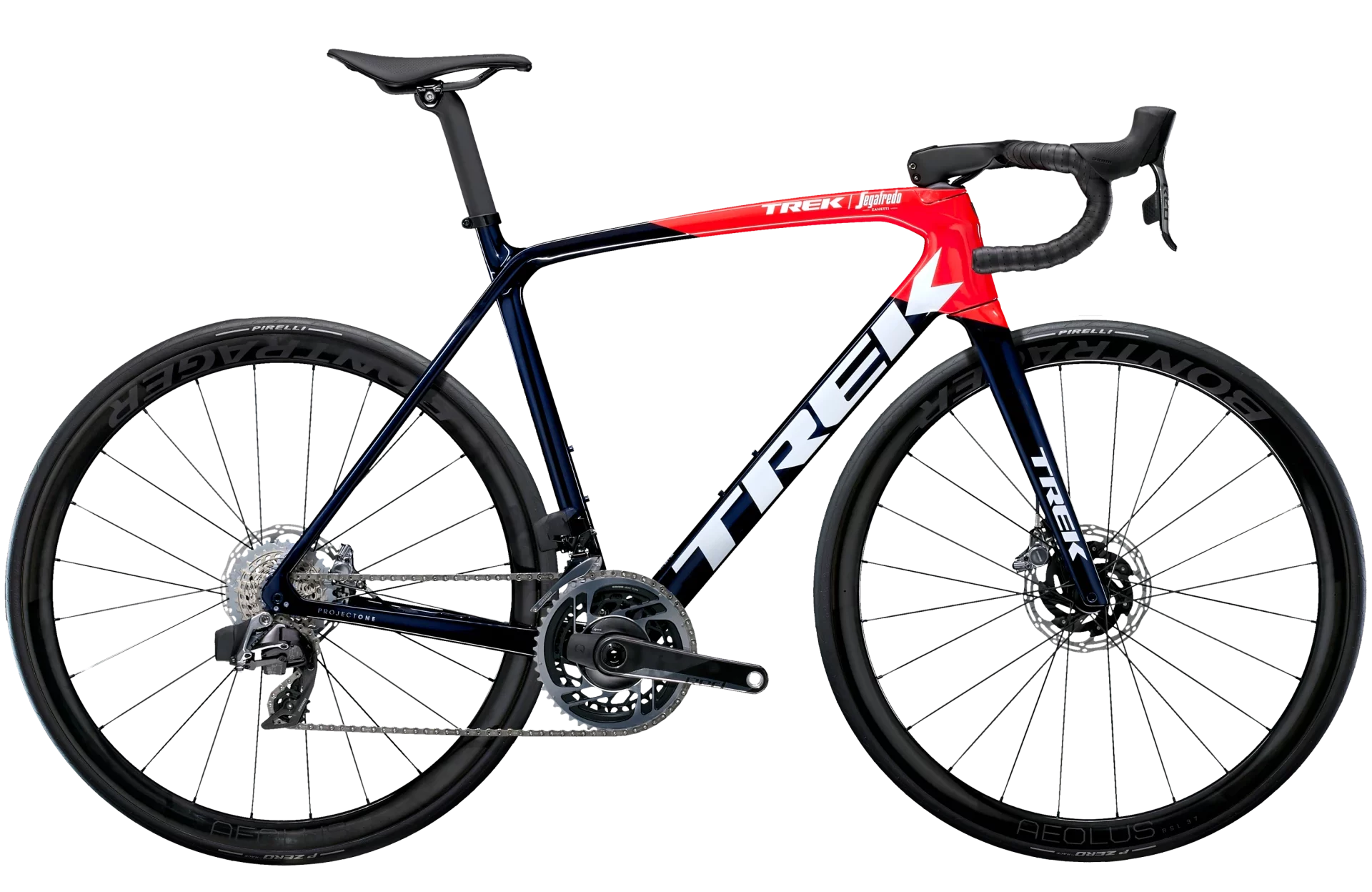
The Trek Emonda is a lightweight bike for the high mountains.
The lightest Trek Emonda frame weighs less than 700g using Trek’s OCLV 800 carbon. This is the bike Richie Porte rode to his third place in the 2020 Tour de France.
The SLR is the lightest and most expensive atop the Trek Emonda models. There are six Emonda SLR options, specced electronic shifting groupsets from SRAM or Shimano.
Next in line is the SL, the mid-range, more budget-friendly option. It has the same frame design and geometry as the SLR but uses the OCLV 500 carbon instead. The groupset choices are Shimano Ultegra Di2 , Shimano 105 Di2 , SRAM Force AXS , or SRAM Rival AXS .
The Trek Emonda SLR and SL framesets are also available separately.
Trek Emonda vs others
2024 Canyon Ultimate vs Trek Emonda
2024 Orbea Orca vs Trek Emonda
2024 Pinarello Dogma F vs Trek Emonda
2024 Pinarello F vs Trek Emonda
2024 Scott Addict RC vs Trek Emonda
2024 Specialized Aethos vs Trek Emonda
2024 Specialized Tarmac SL7 vs Trek Emonda
2024 Specialized Tarmac SL8 vs Trek Emonda
2024 Trek Emonda vs BMC Teammachine SLR
Cannondale BallisTec Carbon
Cannondale BallisTec is a proprietary carbon fiber construction technique used to manufacture Cannondale bicycle frames.
The BallisTec carbon technology utilizes advanced engineering and construction methods to create frames that balance strength, stiffness, and weight. It involves the precise layering and placement of carbon fiber sheets, which are impregnated with epoxy resin and then molded under high pressure and temperature.
The BallisTec carbon is available in three grades.
- BallisTec LAB71 is Cannondale’s latest advancement in carbon construction. Also known as the Series 0 carbon, LAB71 is designed to be the lightest and most advanced, taking over from the Hi-MOD carbon. LAB71 frameset delivers exceptional performance, weight reduction, and overall ride quality.
- BallisTec Hi-MOD stands for High-Modulus, which refers to using high-modulus carbon fibers in the frame. This results in a stiffer and lighter structure, providing enhanced power transfer and a more responsive ride feel. Hi-MOD carbon frames are designed for riders who prioritize performance, stiffness, and weight savings.
- BallisTec is the standard carbon in Cannondale’s frames, which offers a balance of weight, stiffness, and durability at more affordable prices.
Trek OCLV carbon
The OCLV (Optimum Compaction, Low Void) carbon is a proprietary carbon fiber manufacturing technology developed by Trek.
- Optimum Compaction refers to the heat and pressure applied during the curing process to squeeze out excess resin and ensure that the carbon layers are compacted to the optimal density.
- Low Void refers to the goal of reducing microscopic air pockets or voids that can occur in the carbon fiber and create weaknesses.
One of the key advantages of OCLV carbon is its ability to achieve an optimal balance between stiffness, strength, and weight. Trek engineers carefully tune the carbon layup and utilize varying modulus carbon fibers to create stiff frames in certain areas to maximize power transfer while maintaining compliance in other areas to enhance comfort and ride quality.
The OCLV carbon is available in 800 and 500 series.
- OCLV 800 is the highest-grade carbon fiber used by Trek. The carbon modulus is higher in OCLV 800, making it stiffer and lighter. The manufacturing process is more refined, using more advanced carbon and resins, leading to a bike frame that provides top performance levels for stiffness, weight, and strength. OCLV 800 is used in all models with SLR .
- OCLV 500 is a lower-grade carbon but still offers a high level of performance. It has a slightly lower carbon modulus, meaning it’s a bit less stiff and heavier than OCLV 800. OCLV 800 is used in all models with SL .
It’s worth noting that the different OCLV grades don’t only refer to the material itself, but also to the manufacturing techniques used to form the carbon fiber into bike frames. Higher-grade carbon requires more precise manufacturing techniques to take full advantage of its superior material properties.
Cannondale Supersix EVO and Trek Emonda framesets incorporate advanced technologies to enhance their bikes’ performance and ride characteristics.
Here’s an overview of the technologies used in each bike model.
Cannondale retailers
- Cannondale retailers . Use this tool to find your nearest Cannondale retailers.
- Trek online shops . Australia, Austria, Canada, Germany, Netherlands, United Kingdom, United States
- Trek retailers . Use this tool to find your nearest Trek retailers.

Alex Lee is the founder and editor-at-large of Mr. Mamil. Coming from a professional engineering background, he breaks down technical cycling nuances into an easy-to-understand and digestible format here.
He has been riding road bikes actively for the past 12 years and started racing competitively in the senior category during the summer recently.
Mr. Mamil's content is for educational and entertainment purposes only. The content is not a substitute for official or professional advice. Please do your own due diligence.
Mr. Mamil participates in the Amazon Services LLC Associates Program, an affiliate advertising program designed to provide a means for us to earn fees by linking to Amazon.com and affiliated sites. We also participate in various other affiliate programs, and at times we earn a commission through purchases made through links on this website.
Privacy Policy
Website Terms
© Mr. Mamil, 2023

- Buyer’s Guide
- Gear Reviews
- Rides+Events
- Training Guide
- Maintenance
Has Zwift been changing the speed of its bikes?
New zwift insider research sheds light on virtual gear differences.
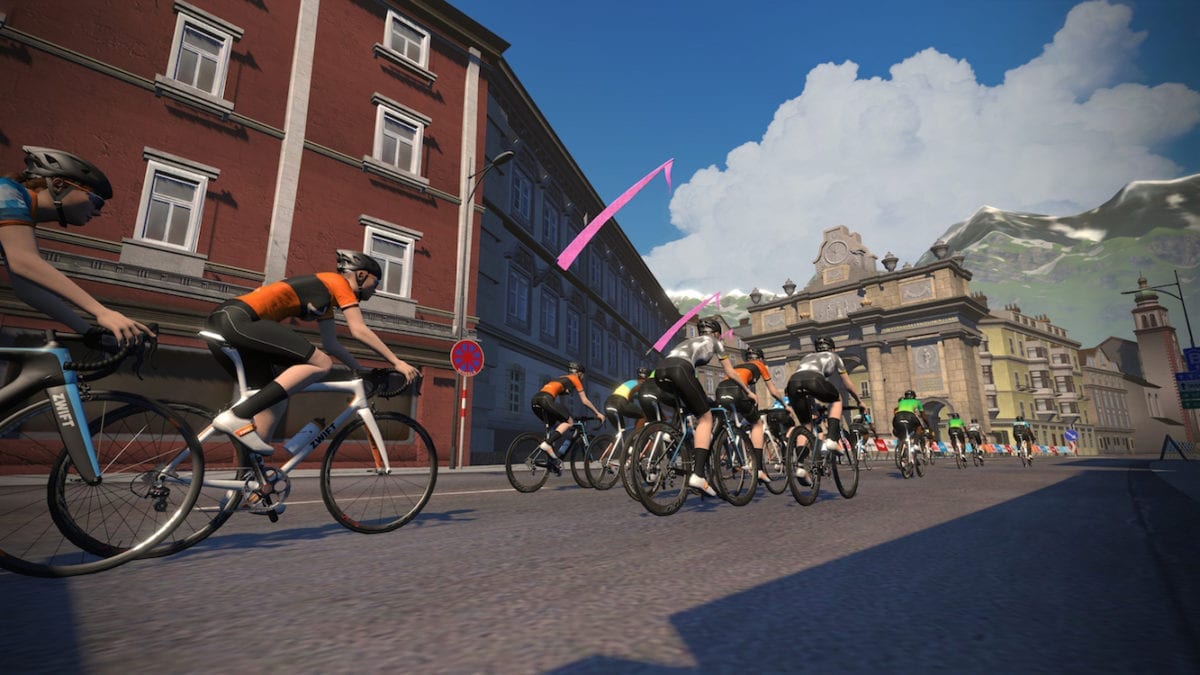
Zwift news and insight website Zwift Insider just published the results of its extensive performance testing of bike frames and wheels in Zwift. Although Zwift says that companies don’t pay to have their virtual products perform better, game engineers will take information about the real-life gear and translate it to its digital counterpart, which creates small discrepancies in performance.
For most Zwift riders, these differences aren’t a big deal and the gear selections they make, paid for with their hard-earned ‘drops’, will likely be based on preference for the real-life products. There are, however, other users that want a competitive advantage for either racing or simply the satisfaction of knowing they’re going as fast as possible. It’s not the first time Zwift Insider did these tests, but some notable changes were found. Some speed discrepancies were due to differences in Zwift’s pack dynamics, while others were changes to equipment made by the developers for unknown reasons.
Different speeds
Zwift Insider used a 183cm, 75kg bot rider going at a steady 300W for all of its tests. The bot rode up Alpe du Zwift twice for each climbing test and Tempus Fugit twice for the flat test. Both tests took about 50 minutes each time.
124 items were tested: 35 wheelsets, 62 road frames, the Zwift concept Z1 “Tron bike”, 16 time trial frames, five MTB frames and five gravel frames.
The biggest changes were seen when testing equipment on the climbs. Fifty of the tested 124 items were now faster by 1.5 seconds or more compared to their previously measured times . Notably, the Felt AR frame was six seconds faster, giving it the same climbing time as the Specialized Venge S-Works frame. Cannondale’s EVO frame was three seconds faster, which makes it the second-fastest climbing bike (Specialized Aethos was first.) The Trek Madone was also three seconds faster on the climb, moving it up to 36th place on the list .
The Zwift Safety bike and Buffalo Fahrrad bikes are both 17.5 seconds slower than before on the climbs and 15 seconds slower on the flats, making the fun bikes truly a symbol of riders who couldn’t care less about their digital segment times.
Inexplicably, the Lauf True Grit bike was four seconds slower on the flat and 24 seconds slower on the climb, making it much slower than most other gravel bikes in the game.
On the flats, the Roval Alpinist CLX wheels were two seconds slower than previously, while the Zwift 50mm carbon wheels were 3.5 seconds faster. A number of frames also gained 1.5 seconds of speed on the flats: Cannondale Synapse, Giant Propel Advanced SL Disc, Giant TCR Advanced SL, Ridley Noah Fast Disc, Canyon Lux and Specialized Epic S-Works. The Focus Izalco Max 2020 and Pinarello Dogma F went the other way, measuring 1.5 seconds slower than before.

- Email address: *
- Name This field is for validation purposes and should be left unchanged.
- Itzulia Basque Country stage 2 live - A stage set for the sprinters
New Trek Emonda gets the aero treatment
Trek launches sub-700g Emonda frame with aero tubing, OCLV 800 carbon, H1.5 fit and threaded bottom bracket
Trek has today announced the launch of its new flagship lightweight road bike , the Emonda. The latest iteration of which sees improvements in aerodynamics, new OCLV 800 carbon fibre, H1.5 geometry and comes alongside the launch of new Bontrager Aeolus wheels and all-new an integrated Aeolus bar-stem.
Best road bikes Best carbon road bikes Trek road bikes
The launch sees two new frames; the flagship Emonda SLR and the more budget-friendly Emonda SL, both of which share the same tube shapes - and therefore the same aerodynamic efficiency - but differ by way of carbon layup and specifications. There are no women's specific models, instead, Trek relies on adjustments such as narrower handlebars and shorter stems for smaller sized frames.
The new Emonda SLR is claimed to be the brand's 'fastest climbing bike', balancing an offset of increased weight and reduced drag to maximise seconds saved over the course of a climb. In Trek's testing, the new bike can save a rider 19.1 seconds per hour on a simulated replica of the 8.1 per cent slopes of Alpe D'Huez, and, It'll even save you 22.8 seconds per hour on Zwift Epic KOM - a sign of the times.
While the new Emonda does see a weight gain compared to its ancestors, an unpainted frame remains under 700g, with a frame and fork combining to weigh just 1.063kg (with hanger, but without paint).
According to Trek, this is made possible by the upgrade to OCLV 800; a new, proprietary, higher-modulus carbon-fibre layup that has been two years in the making. OCLV 800 is 30 per cent stronger than the OCLV 700 carbon used on the former model and Trek was, therefore, able to use less overall material for the same stiffness and durability. The result is around an eight per cent (~60 gram) saving for the same frame shape.
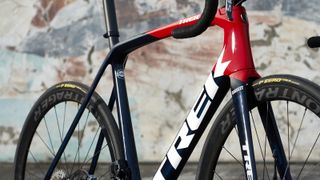
Aerodynamically, the new model halves the deficit between the old Emonda and the current Madone. Thanks to updated tube shaping along with the updated wheels and bar-stem combo, the new Emonda is claimed to be 183 grams of drag faster than its forebear, and save a minute-per-hour over flat ground at an average of 350 watts.
Traditionalists and rim brake purists might want to look away now, as the new Emonda has committed to disc brakes only for its latest iteration, however, unlike the recently launched new Giant TCR , the Emonda SL and SLR are compatible with both electronic and mechanical groupsets.
Get The Leadout Newsletter
The latest race content, interviews, features, reviews and expert buying guides, direct to your inbox!
Tyre clearance is officially restricted to 28mm, which is less progressive than most would expect, however, this does allow for 4mm of clearance and 2mm extra of tolerance. The new model also sees a switch to Trek's latest bottom-bracket standard, T47, a threaded bottom bracket that Trek says allowed a lighter frame weight, and has gained plaudits for being reliable, adaptable, serviceable, and well, for just not being press fit.
Foregoing the H1 and H2 fit options which allowed for two different levels of 'aggressiveness' in fit position. The new Emonda is given H1.5 geometry, which unsurprisingly, sits halfway between the two former options. Compared to the competition, the new Emonda remains a relatively racy proposition, sharing a geometry chart with the brand's aero Madone.
Available models and Project One
The new Emonda will be available via Project One, Trek's custom paint scheme, with ICON and KOM colour schemes, as well as Project One Ultimate, which equates to a fully custom option from any of Trek's colour palettes and specification options.
Off the shelf, the following models are available:
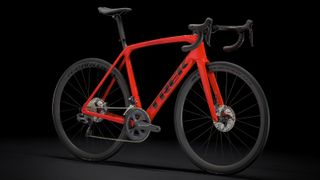
The Emonda SL, as mentioned, shares the exact same tube profiling as the SLR, but is made using OCLV 500 carbon fibre, a heavier - and cheaper - layup. Spec also differs in that it doesn't get the new Aeolus RSL wheels or bar-stem, instead topping out with the Aeolus Pro 37 wheels and either SRAM Force eTap AXS or Shimano Ultegra Di2 groupsets.
- Emonda SL 5: (US$2699 / €2599 / £2275 / AU$3999.99)
- Emonda SL 6: (US$3299 / €3299 / £2900 / AU$TBC)
- Emonda SL 6 Pro: (US$3799 / €3799 / £3350 / AU$5499.99)
- Emonda SL 7: (US$5499 / €5499 / £4850 / AU$7499.99)
- Emonda SL 7 eTap: (US$5999 / €5999 / £5250 / AU$TBC)
- Emonda SL Disc Frame Set: (Pricing TBC)
- Emonda SLR 6: (US$6699 / €6199 / £5450 / AU$TBC)
- Emonda SLR 7: (US$8299 / €6699 / £5900 / AU$10249.99)
- Emonda SLR 7 eTap: (US$8799 / €7799 / £6850 / AU$TBC)
- Emonda SLR 9: (US$11999 / €10999 / £9700 / AU$TBC)
- Emonda SLR 9 eTap: (US$11999 / €10999 / £9700 / AU$TBC)
- Emonda SLR Disc Frame Set: (Pricing TBC)
New Bontrager Aeolus wheels
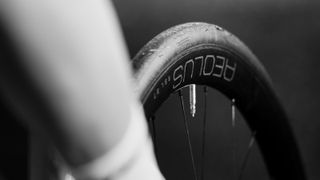
Alongside the launch of the new Emonda, Bontrager, Trek's component subsidiary, has announced the launch of an all-new wheel range.
The new range comprises the range-topping Aeolus RSL 37, the performance-on-a-budget Aeolus Pro 37, and the most cost-effective, entry-level Aeolus Elite in a choice of 35 or 50mm depths. All new models are tubeless-ready and come complete with rim strips, traditional rim tape, and a tubeless valve. None of which have a rider weight limit and all are backed by Bontrager's lifetime warranty.
- More info: Bontrager launches three new wheelsets alongside new Trek Emonda
New Bontrager Aeolus Bar-stem
There is also a new Bontrager Aeolus one-piece bar-stem combo, available in widths from 38cm to 44cm, and with stem lengths ranging from 80mm to 120mm, although, as is often the requirement from pro riders, we expect longer stem lengths to follow. Weights range from 272g to 295g.
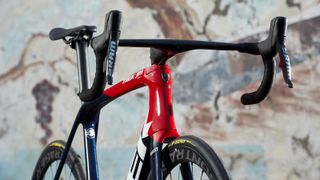
The Aeolus bar-stem is Blendr compatible, and is claimed to be worth seven watts over the previous XXX bar-stem, and has cleverly hidden external cable routing that combines aerodynamic performance with hassle-free maintenance. A true win-win in our eyes.

Thank you for reading 5 articles in the past 30 days*
Join now for unlimited access
Enjoy your first month for just £1 / $1 / €1
*Read any 5 articles for free in each 30-day period, this automatically resets
After your trial you will be billed £4.99 $7.99 €5.99 per month, cancel anytime. Or sign up for one year for just £49 $79 €59

Try your first month for just £1 / $1 / €1

As the Tech Editor here at Cyclingnews, Josh leads on content relating to all-things tech, including bikes, kit and components in order to cover product launches and curate our world-class buying guides, reviews and deals. Alongside this, his love for WorldTour racing and eagle eyes mean he's often breaking tech stories from the pro peloton too.
On the bike, 32-year-old Josh has been riding and racing since his early teens. He started out racing cross country when 26-inch wheels and triple chainsets were still mainstream, but he found favour in road racing in his early 20s and has never looked back. He's always training for the next big event and is keen to get his hands on the newest tech to help. He enjoys a good long ride on road or gravel, but he's most alive when he's elbow-to-elbow in a local criterium.
The best cycling watches of 2024 - track your fitness on and off the bike
Workers' rights groups pursue Specialized for portion of $650K unpaid wages and benefits to factory workers
Michael Rogers quits role as UCI Head of Innovation and Esport
Most Popular
By Simone Giuliani March 31, 2024
By James Moultrie March 31, 2024
By Barry Ryan March 31, 2024
By Kirsten Frattini March 31, 2024
By Kirsten Frattini March 30, 2024
By Barry Ryan March 30, 2024
By Peter Stuart, Will Jones March 30, 2024

Subscribe to my YouTube channel for video reviews.
Trek Émonda Bikes Compared: Which One to Choose?
CyclistsHub is supported by its readers. We may receive a commission if you buy products using our links.
In this article, I’ll help you navigate the Trek Émonda aero road bikes by comparing the Émonda SL 6 to SLR 9 .
You will also learn:
- Who are they best suited for?
- Why I think you shouldn’t buy Trek Émonda with SRAM groupset.
- And which model gives you the best value for your money?
KEY TAKEAWAY
Trek Émonda bikes are ideal for climbing and hilly terrain. They are the lightest bike family of all Trek road bikes . The models differ in components (e.g., electronic shifting) and frames. The more expensive ones are usually lighter and have a higher-grade carbon frame, but usually diminishing returns.
Let’s dive deeper to help make your decision easier.
This article compares Trek Émonda Gen 6 and 7. The main difference between Émonda Gen 6 and Gen 7 is that Gen 6 has IsoSpeed decoupler, while Gen 7 has IsoFlow.
Trek Émonda ALR 5 to SLR 9
The following table summarizes the main differences between all Émonda road bikes.
Émonda Pros & Cons Summary
I summarized the pros & cons of the Émonda series below.
Émonda Pros
- Lighter than Madone road bikes
- Aluminum and carbon models are available
- Relaxed geometry
- Availability in multiple sizes and colors
- Integrated cable routing
- Lifetime warranty
Émonda Cons
- Slower than Madone road bikes
- Narrow tire clearance (28mm)
Émonda Main Features
Let me now explain the most important features of the Trek Émonda aero bikes.
Frame and Geometry
The Émonda bikes are part of Trek’s road bike lineup . They’re made of aluminum or carbon .

The names of the bikes have abbreviations that refer to the type of material used for the frame:
- ALR are aluminum frame bikes.
- SL are bikes with 500 series OCLV* carbon (mid-range).
- SLR are bikes with 800 series OCLV carbon (high-end).
*OCLV carbon is Trek’s patented carbon fiber process ( learn more ).
ALR Émondas are great entry-level road bikes , thanks to their affordability. However, they are still a bit more expensive than less-known competitors.
SLs are the best mid-range option. They are slightly heavier than SLRs but about 25% cheaper.
And SLRs are ideal for people who have more money to spend and don’t want to compromise.
Most Émondas are available in 47-62 sizes and multiple colors giving you a wide range of options.
Their geometry is more relaxed than on other racing bikes, so you won’t experience as much strain on your lower back and neck. The following picture shows the comparison with Specialized Tarmac SL 7.

Weight & Aerodynamics
Trek Émonda frame weighs 760g in size 56. The highest-end Émonda even weighs below the UCI 6.8 kg limit. However, low weight is not everything. Stiffness and aerodynamics are also important.
Trek claims Émonda frames are also relatively stiff and aero (of course, less aero than Madone). They are 18 seconds per hour faster at 8% gradients. ( Source ) However, more information on the methodology is not available.

Émondas are so lightweight also due to the absence of an IsoSpeed decoupler that adds weight.
Wheels and Tires
On some Émonda models, the wheels may be different, but typically, they come with Bontrager Aeolus Pro 37 wheels.
Of course, the low-end models have cheaper aluminum wheels . Fortunately, all Émondas come with tubeless-ready wheels. But remember, the tires are clinchers. So, if you want tubeless tires, you have to buy them separately.
One of the things that surprised me is that the lower-end Émondas have 28mm tires, while the higher-end only have 25mm. Most road bikes these days (except for some aero bikes) have 28mm or 30mm tires.
Unfortunately, Émondas only have tire clearance for 28mm tires.
Unsurprisingly, the Émonda bikes have a 2X drivetrain, as is customary for road bikes.
Trek fits them with Shimano and SRAM groupsets, and the number in the bike name indicates the groupset.
- Models ending with 5 use Shimano 105 (R7000) groupset.
- Models ending with 6 use Shimano Ultegra , 105 Di2 (R7100) or SRAM Rival AXS groupsets.
- Models ending with 7 use Shimano Ultegra Di2 (R8100) or SRAM Force AXS groupsets.
- Models ending with 9 use Shimano Dura-Ace Di2 (R9200) or SRAM Red AXS groupsets.

Interestingly, the Émondas with SRAM are heavier than the Émondas of the same series with the Shimano groupset. In addition, those with Shimano are also cheaper.
This is somewhat strange because Shimano retail prices are higher than SRAM. That’s why I recommend choosing Trek bikes with Shimano groupsets unless you prefer SRAM.
TIP : You might also be interested in this comparison of Shimano vs. SRAM .
So, which Trek Émonda bike is the best?
If you’re considering buying an Émonda, I suggest a model with a Shimano groupset. They are lighter and less expensive than the equivalent SRAM models.
For better value, consider the Émonda SL. It’s around 30% cheaper than the SLR but offers almost the same performance. From all models, I believe the Émonda SL 6 Pro with the Shimano 105 Di2 is the best deal.
However, if you don’t want to compromise, go for the SLR, which is more expensive but lighter.
Trek Émonda FAQ
Trek Émonda bikes are for pro cyclists, competitive roadies, and enthusiast cyclists who want a lightweight road bike. They are ideal for hilly, mountainous terrain and short, medium, and long-distance rides.
The main difference between Émonda and Madone is that Émonda is a lightweight road bike, while Émonda is an aero road bike. For more detailed info, please check out my comparison of Émonda vs. Madone .
The main difference between Émonda and Domane is that Émonda is a lightweight aero road bike. Domane is an endurance road bike with wider tire clearance, also suitable for off-road adventures. Domane is somewhere between Émonda and Madone. Learn more in my Émonda vs. Domane comparison.
About The Author

Petr Minarik
Leave a comment cancel reply.
Your email address will not be published. Required fields are marked *
Save my name, email, and website in this browser for the next time I comment.
Start typing and press enter to search
Cannondale SuperSix EVO Hi-Mod review - the all-round racer's choice
The New SuperSix EVO still provides race bike pedigree, making it one of the best road bikes on the market
- Sign up to our newsletter Newsletter
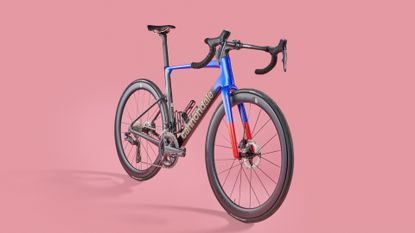
The Cannondale SuperSix EVO platform has long been hailed as one of the best race bikes, and the fourth generation is no different. The latest iteration offers low weight and supreme stiffness, and now offers a more aerodynamic platform that won't hold you back on the flats either. And did we mention, it handles like a dream! It is a racing thoroughbred though, so don't expect all the compliance in the world from this out-and-out race bike.
Super stiff, responsive frame
Planted handling which responds quickly without feeling unwieldy
A frameset that is more aerodynamic than many other climbing bikes
Slightly compromised compliance on longer rides
You can trust Cycling Weekly. Our team of experts put in hard miles testing cycling tech and will always share honest, unbiased advice to help you choose. Find out more about how we test.
- Value and conclusion
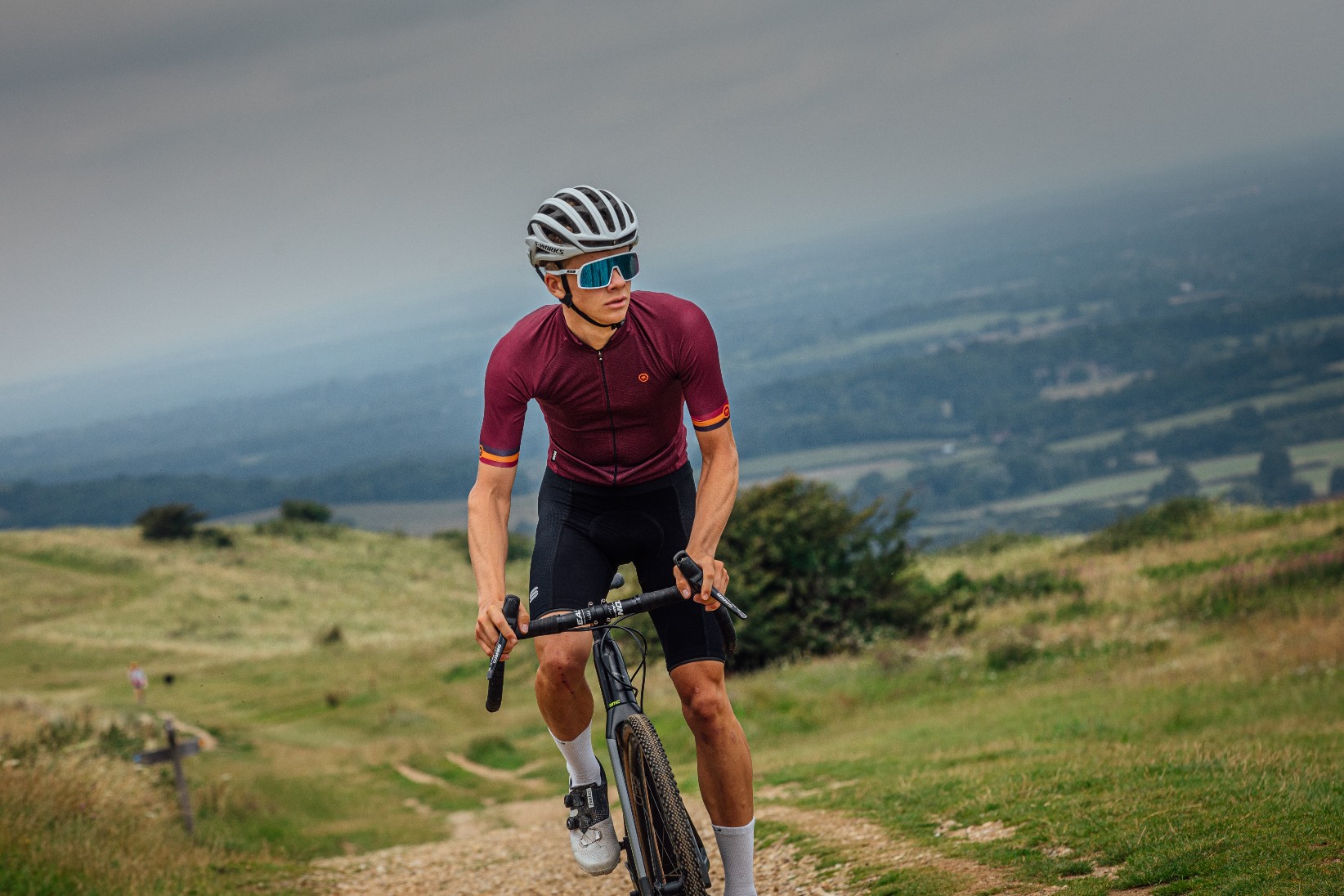
Back in February, Cannondale released the fourth generation of its much-loved SuperSix Evo. The race bike, which holds quite the reputation, saw an aerodynamic redesign, as well as a frameset hierarchy changes. The introduction of the LAB71 framesets , which dethroned Hi-Mod as the range-topping build option, made headlines with a price tag of $15,000 / £12,500.
Retailing for a much more respectable $8,300 / £8,250, the Hi-mod Ultegra Di2 we had on test performed as well as this bike heritage would lead you to expect, boasting exemplary handling and super stiffness. The SuperSix platform may be Cannondale's climbing bike, but with all the new updates to aero and integration, this might just be one of the best road bikes on the market.
Cannondale SuperSix EVO Hi-mod: The Frame
In recent years, we have seen a trend of lightweight bikes becoming more aero, and aero bikes becoming more lightweight. After completely remodelling the SuperSix from its previous generation, the new SuperSix Evo has continued down a more aerodynamic path, receiving some serious revamping for 2023.
As we mentioned before, this year Cannondale has dethroned the SuperSix EVO Hi-Mod by adding a further tier to the range in the form of the LAB71. All three of the framesets on the market now though, share the same remodelling and lots of the same tech.
The biggest visual change between the SuperSix Evo V3 and V4 is an all-round aerodynamic clean-up of the frame shape. The 2023 race bike sits with a more compact stance over the previous iteration, featuring a more steeply sloped top tube and lower dropped seat stays. The fork has also been widened to reduce high pressure air build up around the front wheel, which not only makes for smoother airflow but also gives the new SuperSix tire clearance of up to 34mm.

Cannondale SuperSix Evo Hi-Mod Front end
Cannondale says the design is the result of hours of wind tunnel testing and the use of computational fluid dynamics - software that can cycle through hundreds of virtual designs and test them for aerodynamic efficiency. One touch I personally love is the fork blade - the through-axle is only visible on the side it's tightened from, which makes for such a clean look.
The product of all this redesign is a much more refined-looking machine, which Cannondale claims saves 17 watts at 45kph when compared to the previous generation. The new Cannondale is undoubtedly sleek - but the American brand has also implemented lots of improvements and changes beyond what meets the eye.
Cannondale has also taken a new approach to internally routed headsets. The new 'Delta Steerer' is no longer round, but a triangular design which allows cables to pass either side of the steerer. Attaching standard stems is still possible thanks to a few shims, which were less finickity than I had imagined to set up.
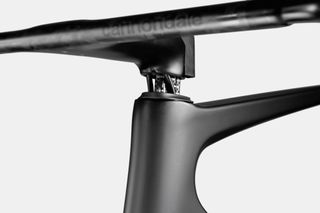
A closer look at the new Delta Steerer
One welcome change is the move back to BSA 68mm threaded bottom bracket system. This is a trend across a lot of the Cannondale range which I first saw on the Cannondale Topstone Carbon 3 which I reviewed earlier this year. Press-fit bottom bracket standards can be notoriously hard to navigate as a consumer, and even if you leave that all up to the bike shop, then you may still be infuriated by the creaks often heard from complaining press-fit systems.
Cannondale also includes aero bottles and cages with the new SuperSix, which can also take round bottles too.
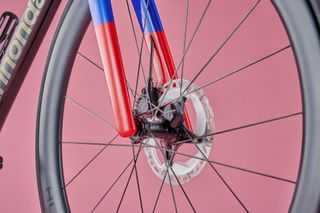
We've mentioned aero efficiency, but how does the new machine stack up with weight and compliance?
Well, as we mentioned before, the Hi-mod no longer sits as the range-topping frameset, but that doesn’t make it heavy. In fact, the LAB71 frameset costs more than the Hi-mod, yet it only saves a minute 40 grams - that's about one large SIS gel ... The full build we had on test came in at 7.69Kg (54) which sits in a similar ballpark to many of its competitors at this price point.
While Cannondale has dropped the seat stays in a bid for more frame compliance, they have also fitted a wider seatpost than on the V3, so these changes seem to cancel one another out. It's important to note here that this really is a bike for racers and serious riders, so the firm ride quality shouldn't come as too much of a shock.
Cannondale SuperSix EVO Hi-mod: The build
The full name of the model we had on test is the Cannondale SuperSix EVO Hi-Mod Ultegra Di2 - quite a mouthful, but it features exactly what it says on the tin.
Our test bike was shod in the latest 12-speed semi-wireless Ultegra R8170 , and the performance was just what you would expect - precise, quick and seemless. The bike comes stock with an 11-30 cassette alongside 52/36 chainrings which offer plenty of gear range.
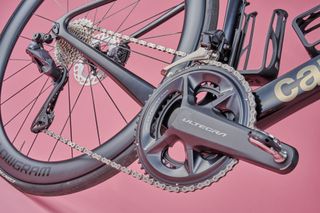
Cannondale SuperSix Evo drivetrain
Cannondale itself provides the wheels, with its Hollowgram SL50s, which as the name suggests, are 50mm deep. The wheels come tubeless ready, although out of the box the continental Grand Prix's are set up with inner tubes.
The RSL50s wheels have a 21mm internal rim width and a super wide 32mm external rim width - this seems super wide, but it made for an almost totally flush edge between the 25mm stock tires (which came up a little large) and the rim, which is great for smoothing airflow.
Finishing kit-wise, Vision handles the bars with its Trimax carbon aero bar, while Prologo provides the saddle. This build does not come with a one-piece bar and stem combination but does feature totally internal cable routing.
Cannondale SuperSix EVO Hi-mod: The ride
Since its first release all the way back in 2011 the SuperSix EVO has long been hailed as one of the best-handling road bikes on the market. With such heritage to live up to, it is no surprise that Cannondale barely touched the geometry, with the only change being 2mm of length added to the chain stays to accommodate wider tires.
To us here at Cycling Weekly though, it is music to our ears. The 'if it ain't broke, don't fix it' approach taken by Cannondale has certainly delivered - this bike handles superbly.
The testing grounds for me consisted of some pretty varied Oxfordshire terrain, which include a lot of one to five-minute climbs.
My first ride on the new SuperSix was a short one-hour blast around a local loop with some short climbs and twisty roads, and early impressions were strong. The bike instantly boasted that zippy feel on acceleration which really brings a fun element of riding, certainly helping me to feel more fit than I currently am!
Once up to speed, the bike held momentum really well too, and while I won't try and tell you my mentally calibrated power meter could feel a 14 watt difference at 45kph, but I can say with confidence, that the SuperSix won't penalize you on flatter terrain.
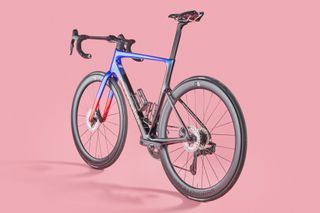
So the bike impressed me initially, but how did I get on with it longer term? Well, a few Cotswold jaunts allowed me to really get personal with the new race bike, and it continued to impress.
Firstly, that handling - though we may not have the luxury of 10km Alpine descents here in the UK, we do have enough technical roads to get a good feel for a bike's character, and as I briefly mentioned before, it feels brilliant.
The SuperSix floats an impressive balance between being quick to handle, whilst not feeling overly skittish. I was able to push hard on descents I knew well with full confidence in the bike even early on in my test period - needless to say the Shimano disc brakes took care of stopping without any hesitation.
Another aspect of any bike which takes a while to figure out is comfort. Once I had got settled with my position on the new SuperSix, I did notice that on longer rides, there was a noticeable amount of vibration transmitted to my hands and through my back - I think the wider seat post and more aero tube profiles are likely to blame here. It is not by any means a deal breaker, more a word of warning that this is an out-and-out race bike, but compared to our Race Bike of the Year winner , the Cervelo S5, this was just a little bit harsher. One thing I would recommend here is a switch out to 28mm tires, as this would undoubtedly help, and provide more cornering grip in the process.
My other gripe from a fitment point of view was the bar width. The Vision Trimax carbon aero bars measured up a huge 440mm from edge to edge, which seems to me slightly dated, especially given this race bike's pedigree. And it's not like you can switch them out easily too, as a full relabelling is needed to change out for different handlebars.
Put the fit elements aside though, which are personal, and this bike is a true racer. The handling is top class, and it responds to every input with ease, making it truly inspiring to ride.
Cannondale SuperSix EVO Hi-mod: Value and conclusion
Overall, the new Cannondale SuperSix Evo Hi-Mod showed a standout performance on all terrain. It certainly still favors the uphills, which is what made it our Climbing Bike of the Year, but the new bike is more versatile than ever before.
As far as value is concerned, the SuperSix Evo Hi-Mod Ultegra Di2 is by no means cheap ($8,300 / £8,250), but it does offer nearly all of the performance of the LAB71 range-topping model, for a huge $7,000 less. In my view, this makes the Ultegra Di2 model one of the best value bikes for a keen racer that doesn't have the budget for a hyperbike, but wants a reliable performance-focused racing machine.
Compared to rivals at this price point, Cannondale does well to keep the price just below its competitors. For example, the Trek Emonda SLR 7 also boasts carbon wheels and Ultegra Di2, but costs $8,999 / £8,799.
It is worth noting though, that the SuperSix Evo 2 retails at $5,500. You don't get a Hi-Mod frame, and wheel specs do take a slight hit, but with the same frame shape and geometry, this is worth a look if budget is a limiting factor.
Cannondale SuperSix EVO Hi-mod : Specs
Thank you for reading 20 articles this month* Join now for unlimited access
Enjoy your first month for just £1 / $1 / €1
*Read 5 free articles per month without a subscription
Join now for unlimited access
Try first month for just £1 / $1 / €1
Get The Leadout Newsletter
The latest race content, interviews, features, reviews and expert buying guides, direct to your inbox!
Joe is Cycling Weekly's tech writer. He's always had a love for bikes, since first riding a two wheeled steed before the age of four. Years down the line, Joe began racing at 16, and enjoyed great experiences internationally, racing in Italy, Spain and Belgium to name a few locations. Always interested in tech, Joe even piloted his Frankenstein hill climb bike to a Junior National Title in 2018. After taking a step back from elite level racing in April 2022, Joe joined our team as a freelancer, before becoming Tech Writer in May 2023.

Specialized is named in a recent workers' rights investigation claiming that the cycling garment company owes $659,000 in unpaid wages and severance to former factory workers.
By Cycling Weekly Published 1 April 24

In-form Italian praises Lidl-Trek team after repeating feat she achieved in 2015
By Tom Davidson Published 31 March 24

World champion becomes seventh man in history to win the race three times
Useful links
- Tour de France
- Giro d'Italia
- Vuelta a España
Buyer's Guides
- Best road bikes
- Best gravel bikes
- Best smart turbo trainers
- Best cycling computers
- Editor's Choice
- Bike Reviews
- Component Reviews
- Clothing Reviews
- Contact Future's experts
- Terms and conditions
- Privacy policy
- Cookies policy
- Advertise with us
Cycling Weekly is part of Future plc, an international media group and leading digital publisher. Visit our corporate site . © Future Publishing Limited Quay House, The Ambury, Bath BA1 1UA. All rights reserved. England and Wales company registration number 2008885.
Ch. 9 The Development of Russia
Ivan i and the rise of moscow, learning objective.
- Outline the key points that helped Moscow become so powerful and how Ivan I accomplished these major victories
- Moscow was considered a small trading outpost under the principality of Vladimir-Suzdal into the 13th century.
- Power struggles and constant raids under the Mongol Empire’s Golden Horde caused once powerful cities, such as Kiev, to struggle financially and culturally.
- Ivan I utilized the relative calm and safety of the northern city of Moscow to entice a larger population and wealth to move there.
- Alliances between Golden Horde leaders and Ivan I saved Moscow from many of the raids and destruction of other centers, like Tver.
A rival city to Moscow that eventually lost favor under the Golden Horde.
Grand Prince of Vladimir
The title given to the ruler of this northern province, where Moscow was situated.
The Rise of Moscow
Moscow was only a small trading outpost in the principality of Vladimir-Suzdal in Kievan Rus’ before the invasion of Mongol forces during the 13th century. However, due to the unstable environment of the Golden Horde, and the deft leadership of Ivan I at a critical time during the 13th century, Moscow became a safe haven of prosperity during his reign. It also became the new seat of power of the Russian Orthodox Church.
Ivan I (also known as Ivan Kalita) was born around 1288 to the Prince of Moscow, Daniil Aleksandrovich. He was born during a time of devastation and upheaval in Rus’. Kiev had been overtaken by the invading Mongol forces in 1240, and most of the Rus’ principalities had been absorbed into the Golden Horde of the Mongol Empire by the time Ivan was born. He ascended to the seat of Prince of Moscow after the death of his father, and then the death of his older brother Yury.

Ivan I. He was born around 1288 and died in either 1340 or 1341, still holding the title of Grand Prince of Vladimir.
Ivan I stepped into a role that had already been expanded by his predecessors. Both his older brother and his father had captured nearby lands, including Kolomna and Mozhaisk. Yury had also made a successful alliance with the Mongol leader Uzbeg Khan and married his sister, securing more power and advantages within the hierarchy of the Golden Horde.
Ivan I continued the family tradition and petitioned the leaders of the Golden Horde to gain the seat of Grand Prince of Vladimir. His other three rivals, all princes of Tver, had previously been granted the title in prior years. However they were all subsequently deprived of the title and all three aspiring princes also eventually ended up murdered. Ivan I, on the other hand, garnered the title from Khan Muhammad Ozbeg in 1328. This new title, which he kept until his death around 1340, meant he could collect taxes from the Russian lands as a ruling prince and position his tiny city as a major player in the Vladimir region.
Moscow’s Rise
During this time of upheaval, the tiny outpost of Moscow had multiple advantages that repositioned this town and set it up for future prosperity under Ivan I. Three major contributing factors helped Ivan I relocate power to this area:
- It was situated in between other major principalities on the east and west so it was often protected from the more devastating invasions.
- This relative safety, compared to Tver and Ryazan, for example, started to bring in tax-paying citizens who wanted a safe place to build a home and earn a livelihood.
- Finally, Moscow was set up perfectly along the trade route from Novgorod to the Volga River, giving it an economic advantage from the start.
Ivan I also spurred on the growth of Moscow by actively recruiting people to move to the region. In addition, he bought the freedom of people who had been captured by the extensive Mongol raids. These recruits further bolstered the population of Moscow. Finally, he focused his attention on establishing peace and routing out thieves and raiding parties in the region, making for a safe and calm metaphorical island in a storm of unsettled political and military upsets.

Kievan Rus’ 1220-1240. This map illustrates the power dynamics at play during the 13th century shortly before Ivan I was born. Sarai, the capital of the Golden Horde, sat to the southeast, while Moscow (not visible on this map) was tucked up in the northern forests of Vladimir-Suzdal.
Ivan I knew that the peace of his region depended upon keeping up an alliance with the Golden Horde, which he did faithfully. Moscow’s increased wealth during this era also allowed him to loan money to neighboring principalities. These regions then became indebted to Moscow, bolstering its political and financial position.
In addition, a few neighboring cities and villages were subsumed into Moscow during the 1320s and 1330s, including Uglich, Belozero, and Galich. These shifts slowly transformed the tiny trading outpost into a bustling city center in the northern forests of what was once Kievan Rus’.
Russian Orthodox Church and The Center of Moscow
Ivan I committed some of Moscow’s new wealth to building a splendid city center and creating an iconic religious setting. He built stone churches in the center of Moscow with his newly gained wealth. Ivan I also tempted one of the most important religious leaders in Rus’, the Orthodox Metropolitan Peter, to the city of Moscow. Before the rule of the Golden Horde the original Russian Orthodox Church was based in Kiev. After years of devastation, Metropolitan Peter transferred the seat of power to Moscow where a new Renaissance of culture was blossoming. This perfectly timed transformation of Moscow coincided with the decades of devastation in Kiev, effectively transferring power to the north once again.

Peter of Moscow and scenes from his life as depicted in a 15th-century icon. This religious leader helped bring cultural power to Moscow by moving the seat of the Russian Orthodox Church there during Ivan I’s reign.
One of the most lasting accomplishments of Ivan I was to petition the Khan based in Sarai to designate his son, who would become Simeon the Proud, as the heir to the title of Grand Prince of Vladimir. This agreement a line of succession that meant the ruling head of Moscow would almost always hold power over the principality of Vladimir, ensuring Moscow held a powerful position for decades to come.
- Boundless World History. Authored by : Boundless. Located at : https://www.boundless.com/world-history/textbooks/boundless-world-history-textbook/ . License : CC BY-SA: Attribution-ShareAlike
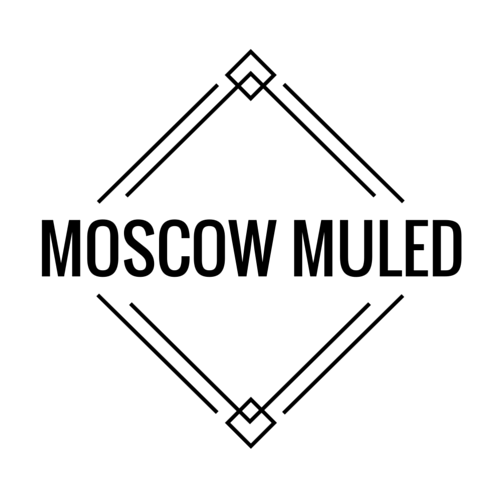
Moscow Muled
Why you should only use moscow mule copper mugs with stainless steel lining.
Dec 01, 2017
Recently in the media there have been many articles warning the public of the dangers of drinking Moscow Mules and other cocktails out of copper mugs. With sensationalist headlines like “ Are Moscow Mule Copper Mugs Really Poisoning People?” you have good reason to be concerned and conduct your own research! As lovers of the traditional Moscow Mule drink and other cocktails served in a copper mug, we wanted to take this opportunity to dive into why it’s so important to always use a stainless steel lined copper mug like ours when enjoying your favorite cocktail.
The Origin of the Copper Mug
The Moscow Mule is a popular drink made of vodka, ginger beer, and freshly squeezed lime served over ice in a copper mug. It’s a refreshing cocktail that is said to have been invented in 1941 in a Los Angeles British Pub called Cock ’n’ Bull. Legend has it the owners of a vodka, ginger beer and copper mug company all found themselves in that pub on the same day lamenting about how slow their sales had been. Together along with the pub bartender, they devised a recipe for the Moscow Mule served in a distinctive copper mug. One of the creators traveled the US taking pictures of patrons drinking the cocktail with Polaroid cameras, a cutting edge invention of the day. As the Polaroids began to circulate, so too did the popularity of this novel cocktail. The Moscow Mule was born.
While originally the copper mug might have been paired with the Moscow Mule purely as a marketing gimmick, it turned out the mugs had some interesting properties that enhanced the popular cocktail. Copper mugs help keep cocktails cold for longer and with less ice than a typical glass. The copper in the mug also reacts with the lime and ginger beer to give the traditional Moscow Mule cocktail more of a ‘kick’. But as it turns out, the kick from the reaction between a pure copper mug and the ingredients of a Moscow Mule might actually be detrimental to your health!
Why Copper Mugs Without Stainless Steel Lining Are Dangerous

While copper is an important essential mineral, it is also a heavy metal that reacts with acidic liquids such as cocktail ingredients. Any acidic drink will corrode the copper contained in a mug without a stainless steel lining, which will then leach back into the drink and increase the level of copper consumed.
In some cases, you may be able to detect a metallic taste in your drink, which can provide a warning that there is too much copper in your drink and that you should not continue drinking it. However, in some cases, the flavors in your cocktail may mask the presence of excessive copper in the drink, thereby leading you to believe that your drink is safe.
The rate at which copper will leach into a drink depends on a variety of factors including the acidity level of the drink, its temperature, the quality of the copper mug, and the length of time the drink remains in the mug – but there is no doubt that copper leaching is inevitable in any copper mug that does not have a protective stainless steel lining, and there is no doubt that the leaching process begins immediately upon contact.
How acidic does a drink need to be before you should be concerned about having it in a copper mug? According to a recent report released by Iowa’s Alcoholic Beverages Division, and in keeping with Food and Drug Administration guidelines, copper should not come into contact with acidic foods with a pH below six. The pH of a traditional Moscow Mule, along with many of your favorite beverages, is well below 6, largely as a result of the alcohol and other acids contained in the cocktail.
The term pH refers to the acidity or alkalinity of liquids and is expressed on a scale of 0 to 14. Liquids with a pH below 7, like lemon juice, are considered acidic while liquids with a pH above 7, like liquid soap, are considered alkaline. Liquids with a pH of 7, like water, are considered neutral. Liquids like wine, beer, fruit juice, soda, tea (and even water with a dash of lemon in it) all have pHs well below 6. In short, the only safe use of a pure copper mug is for drinking water, which has a neutral pH.
Accordingly, if you use a copper mug that is not lined with stainless steel with any drink that is even slightly acidic, the acidic fluids in your drink will cause a chemical reaction which will literally cause you to ingest large amounts of copper, leading to an unhealthy and potentially dangerous concentration of copper in your body.
The matter is so significant that the Food and Drug Administration has prohibited food or drink with pH levels below 6 from coming into contact with copper at licensed premises like bars or restaurants. The Food and Drug Administration also requires that anyone serving beverages through pipes must ensure that sufficient mechanisms are in place to ensure that copper is prevented from leaching into the drinks.
High concentrations of copper are very poisonous and have caused various food borne illnesses. Symptoms of copper poisoning include abdominal pain, diarrhea, vomiting, nausea, and jaundice, according to the U.S. National Institutes of Health . In fact, in one report published in the American Journal of Public Health, researchers discovered an outbreak of nausea, vomiting and diarrhea among party-goers who had consumed cocktails at a party that have been sitting in copper cocktail shakers. The researchers determined that the concentration of copper in the drinks caused symptoms of chemical food poisoning precipitated by the consumption of alcohol on an empty stomach.
While one drink from a copper mug without stainless steel lining won’t kill you, long-term exposure can pose serious health issues such as liver problems and low blood pressure. In some cases, severe copper poisoning can cause liver failure and death.
This recent report comes as no surprise to chefs and food scientists who have, for centuries, known to never use copper cookware with acidic recipes like tomato sauce. Beyond the negative health effects, using copper cookware with acidic foods results in metallic tasting recipes. No thanks!
However, while copper cookware has been used for centuries, the use of copper mugs with cocktails such as the Moscow Mule is a relatively new phenomenon and has only recently achieved widespread popularity. As a result, the health risks of using copper mugs without stainless steel lining have not received the same attention until now.
The Solution: Stainless-Lined Copper Mugs
The good news is that not all copper Moscow Mule mugs are created equal. Some are lined with stainless steel , including our copper mugs . Why is stainless steel lining so important? In short, unlike copper, stainless steel does not corrode or otherwise react when put in contact with acidic liquids. As a result, a cocktail or other drink enjoyed in a stainless steel lined copper mug will not experience any copper leaching, which means that your health is fully protected!
In fact, Iowa’s Alcoholic Beverages Division recommends that if bar and restaurant owners are going to use copper mugs for acidic drinks such as the Moscow Mule, then they should use copper mugs lined with stainless steel in order to avoid copper leaching.
In order to protect the health of our customers, we specifically choose to only manufacture and sell copper mugs made from 100% pure high-grade and food-safe copper with an inner layer of high-grade stainless steel . As a result, you can enjoy your favourite cocktail in one of our copper Moscow mule mugs for years to come without worrying about copper poisoning or other negative health effects.
Cocktails from our Moscow Mule mugs taste pure and fresh. Like the original Moscow Mule mugs, ours are also great insulators that help keep your drink cold and frosty. The stainless steel lining in our copper mugs also has an added functional benefit. In particular, because copper is a very soft metal, it can become damaged by repeated use. Stainless steel plating increases the strength and durability of your copper mug and greatly extends its life!
Cleaning your stainless steel lined copper mug is simple. Clean the inside of your copper mug with warm water, soap and a soft cloth and dry it immediately. Be sure to never wash your copper mug with detergents or in a dishwasher. The exterior of the mug will naturally patina over time, which many of our customers enjoy. If you wish to remove the patina, simply sprinkle a pinch of salt on a slice of lemon, allow the salt to dissolve, and then gently rub it on the surface of the mug. The lemon and salt will form a mixture that will naturally remove the patina and restore the copper’s shine. Once done, rinse with water and dry well.
Did You Enjoy This Article?
Thank you for reading! If you enjoyed this article, you might also like the following articles: How to Clean and Care for Copper Mugs: The Definitive Guide and Top 3 Reasons Why Copper Mugs Make the Best Gift
Relevant Products
Moscow Mule Copper Mug
Mar 05, 2020 • Posted by Moscow Muled
Hi Stacie Culmer, you can handwash your copper moscow mule mugs with any liquid dish soap! Just be sure to never place the mugs in the dishwasher or use any abrasive detergents. :)
Mar 05, 2020 • Posted by Stacie Culmer
What kind of soap do you mean versus detergent?
Leave a comment
Subscribe to our newsletter.
Receive exclusive deals and our latest blog posts straight to your inbox!

IMAGES
VIDEO
COMMENTS
Nov 15, 2019: Shortened the list. Removed 7 and #8: Cervelo R5 and Chapter2 Tere, and 9 and #10: Trek Emonda SL and Specialized Tarmac. Nov 1, 2019: added the Cannondale SuperSix EVO in the 6th spot. Oct 7, 2019: added Chapter2 Tere in #7 slot. Had neglected to test this up the Alpe when it was released back in July.
Your chosen bike frame and wheelset both affect speed in Zwift, so it makes sense for racers to do a little research and choose the best tool for the job. Frame Tests - Introduction While Zwift's 4-star rating system for weight and aero is simple and easy to understand, performance varies even among frames with the same star ratings ...
Cannondale EVO (714,500) 61s: 30: Specialized Aethos S-Works (966,300) ... Total time savings of fastest frame and wheelset over stock Zwift setup (Zwift Steele frame and Zwift classic wheels): 65.5+22=87.5 seconds. Times above based on our climb speed tests, done with a solo 75kg rider at 300 watts up Alpe du Zwift. Our test rider typically ...
The Cannondale SuperSix EVO is an all-rounder race bike.. For years, the Cannondale SuperSix EVO been known for being light, fast, and stiff on the climbs. At one point, many weight weenies were building sub-6kg bikes with the Cannondale SuperSix EVO. In 2023, Cannondale launched the ultra-premium LAB71 version featuring their latest Series 0 (LAB71) carbon, taking over from the Hi-MOD version ...
The Trek Madone was also three seconds faster on the climb, moving it up to 36th place on the list. The Zwift Safety bike and Buffalo Fahrrad bikes are both 17.5 seconds slower than before on the ...
2. 3. Gravel. Canyon has gone fully in on Zwift with a full quiver of machines so if you're into your Canyon bikes you can swap between road, TT, MTB and even gravel. The Grail (along with the ...
Price-wise, the TCR Advanced SL 0 is in the same ballpark as the S-Works Tarmac, Cannondale SuperSix EVO and Trek Emonda. The TCR Advanced SL 0 misses out on a perfect score due to a couple of things.
Bike Comparison. The Cannondale SuperSix EVO 3 and Trek Émonda SL 6 AXS are both carbon frame race bikes with hydraulic disc brakes. The SuperSix EVO 3 has aluminum 700c aluminum wheels, while the Émonda SL 6 AXS has carbon 700c carbon wheels and better components.
The Trek Émonda SL 7 and Cannondale SuperSix EVO 2 are both carbon frame race bikes with high-end components and hydraulic disc brakes. ... SuperSix EVO 2 2024 Cannondale. Frame. Ultralight 500 Series OCLV Carbon, Ride Tuned performance tube optimization, tapered head tube, internal routing, DuoTrap S compatible, flat mount disc, 142x12mm thru ...
Bike Comparison. The Cannondale SuperSix EVO 3 and Trek Émonda SL 6 are both carbon frame race bikes with hydraulic disc brakes. The SuperSix EVO 3 has aluminum 700c aluminum wheels, while the Émonda SL 6 has carbon 700c carbon wheels and better components.
#CyclingInsider #TrekEmondaSL7 #CannondaleSuperSixEvo #ShimanoUltegraDi2 Hello ladies and gents!In this episode, I bring you a head-to-head compari...
Trek Emonda with Meilenstein Lightweight @ 300 watts: 6:33 Cervelo S5 with Zipp 808 @ 300 watts: 6:37 Concept Z1 (Tron) @ 300 watts: 6:38 ... Important note: this post contains speed test results for Zwift frames or wheels. These results may change over time, and a bike's performance relative to others may also change. ...
Trek launches sub-700g Emonda frame with aero tubing, OCLV 800 carbon, H1.5 fit and threaded bottom bracket ... It'll even save you 22.8 seconds per hour on Zwift Epic KOM - a sign of the times ...
Trek fits them with Shimano and SRAM groupsets, and the number in the bike name indicates the groupset. Models ending with 5 use Shimano 105 (R7000) groupset.; Models ending with 6 use Shimano Ultegra, 105 Di2 (R7100) or SRAM Rival AXS groupsets.; Models ending with 7 use Shimano Ultegra Di2 (R8100) or SRAM Force AXS groupsets.; Models ending with 9 use Shimano Dura-Ace Di2 (R9200) or SRAM Red ...
In the ZwiftInsider tests the Cannondale Evo matches the Tarmac Pro on aero, but is 5 seconds slower up L'Alpe du Zwift. I think that ranking has more to do with marketing paid to Zwift than actual data :). The Zwift bikes are each a bit of a dog on the climbs. Clearly the Zwift carbon bike is a cheap, over-painted OEM frame.
For example, the Trek Emonda SLR 7 also boasts carbon wheels and Ultegra Di2, but costs $8,999 / £8,799. It is worth noting though, that the SuperSix Evo 2 retails at $5,500.
Gear Range. A bike with lower gearing will be easier to ride up steep hills, while a higher top end means it will pedal faster down hills. Lowest gear. (climbing) 41 mph. Émonda SL 6 Pro. 41 mph. SuperSix EVO Carbon Disc Ultegra. Highest gear.
The Cannondale SuperSix EVO 1, Trek Émonda SLR 7, and Trek Émonda SLR 7 eTap are all carbon frame race bikes with hydraulic disc brakes. The Émonda SLR 7 has better components.
The SuperSix EVO is billed as an "aero climbing bike"-that is, Cannondale is trying to find the holy grail of cycling-a stiff, fast aero bike that is also featherlight so it climbs well. Some say they've achieved that with the newest SuperSix EVO, rolled out in the summer of 2019. Kudos to Zwift, who have set the bike up in-game to ...
1 ½ oz tonic. ½ oz simple syrup. 1 lime squeezed. 5 grapes (mashed) Instructions: Mash grapes and mix them with vodka in a shaker. Add syrup, lime juice, and ice. Shake the mixture vigorously and strain into a glass over fresh ice. Top with tonic water, and your very own fix of a American Mule with a twist is ready!
Ivan I (also known as Ivan Kalita) was born around 1288 to the Prince of Moscow, Daniil Aleksandrovich. He was born during a time of devastation and upheaval in Rus'. Kiev had been overtaken by the invading Mongol forces in 1240, and most of the Rus' principalities had been absorbed into the Golden Horde of the Mongol Empire by the time ...
In fact, Iowa's Alcoholic Beverages Division recommends that if bar and restaurant owners are going to use copper mugs for acidic drinks such as the Moscow Mule, then they should use copper mugs lined with stainless steel in order to avoid copper leaching. In order to protect the health of our customers, we specifically choose to only ...